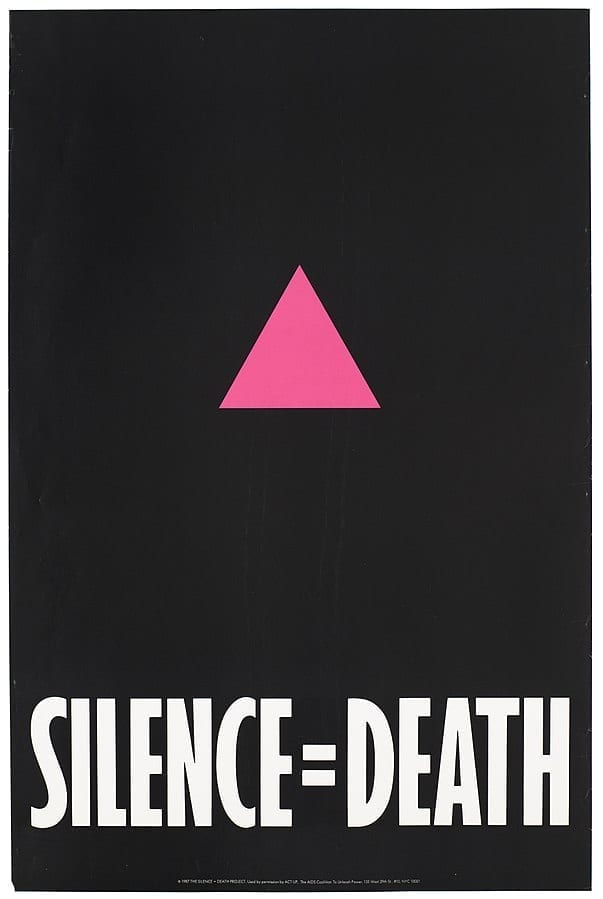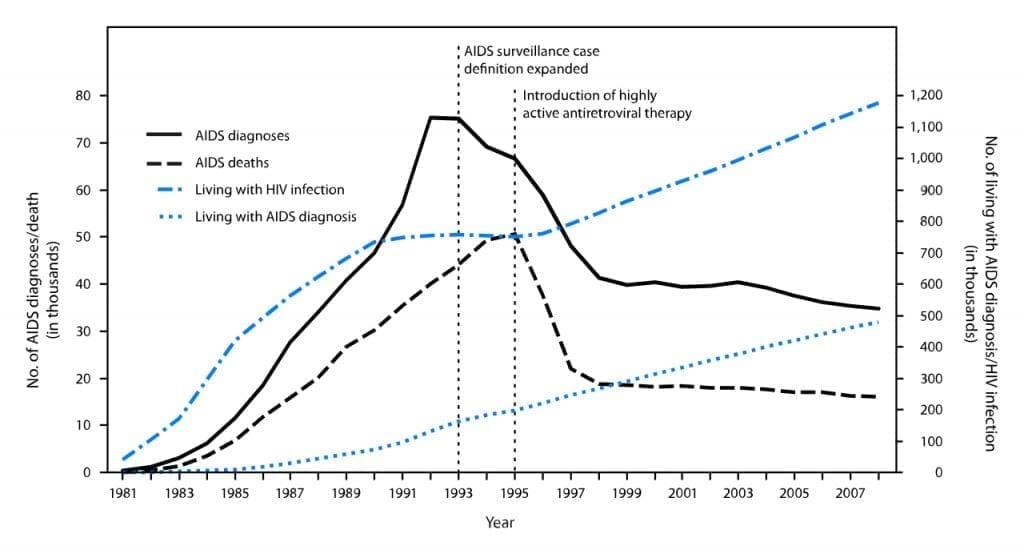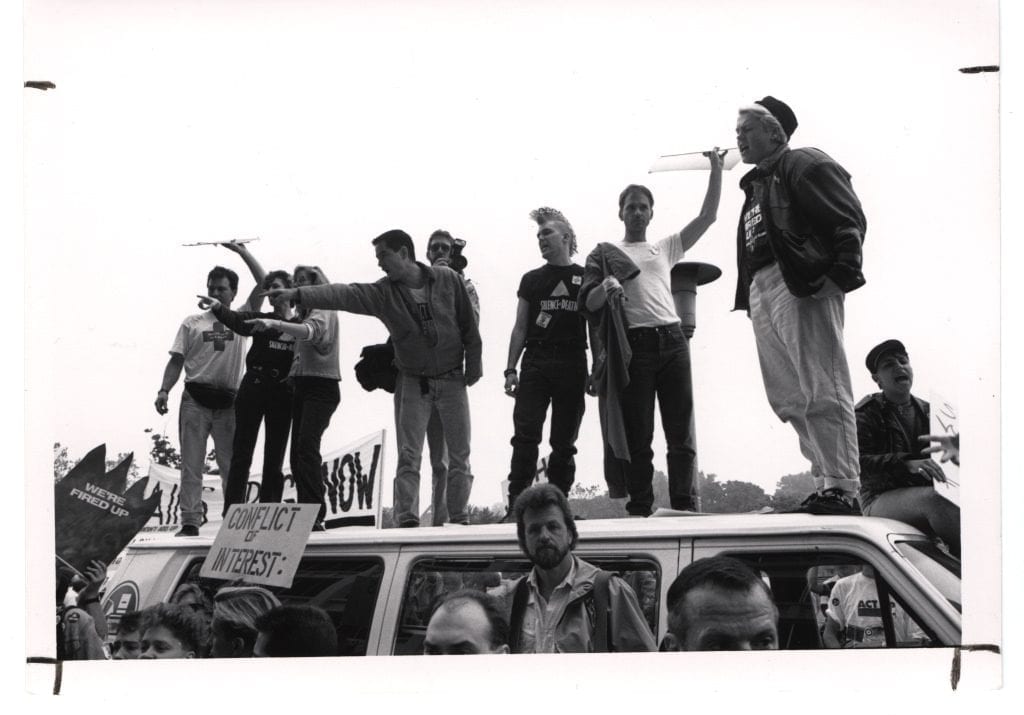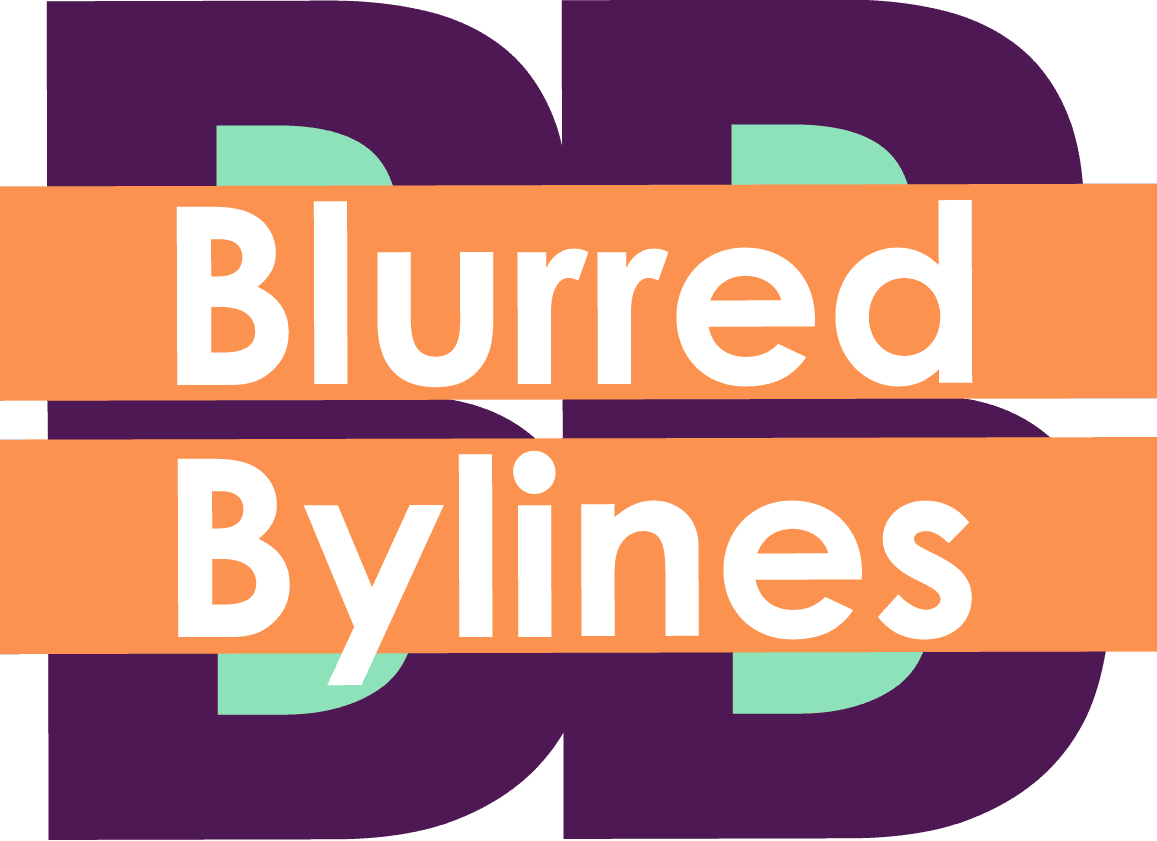Silence = Death: The AIDS Crisis Was So Much Worse Than We Talk About

ACT UP protesters demonstrate at FDA’s headquarters in Rockville, Maryland in 1988. (Source)
By Shari Rose ~ March 23, 2019
From Team America’s “Everyone has AIDS” song to the condom company that poked fun at AIDS as part of their marketing campaign on Tinder (“Only swipe right if you like: incurable virus that destroys immune systems.”), AIDS is a punchline. Even those supposedly ‘woke’ tv shows like The Mindy Project found a way to laugh at this epidemic that killed nearly 450,000 Americans in 19 years, and continues to kill an average of 15,000 people in the U.S. every year.
It’s easy to forget that the AIDS crisis hit its peak 25 years ago. From 1981 to 2000, more Americans died of AIDS than American deaths in World War II. You wouldn’t know that from the way AIDS is poked fun at in the last decade.
Entire communities were wiped out in New York City, San Francisco, Los Angeles, Atlanta and more. HIV-positive gay men were disowned by their families and left to die alone, buried in unmarked graves. Hospitals turned AIDS patients away and doctors refused to treat people as they lay suffering in front of them.
Many of those who lived through the AIDS crisis in the 1980s and 1990s are still alive today. They remember going to funerals and memorials every week, losing friends and loved ones, protesting against the inaction of presidents who watched the death toll rise and remain silent and knowing that nearly half of Americans at the time believed AIDS was exactly what gay communities deserved.
This wasn’t a long time ago. The AIDS crisis is recent American history. And if anything you’ve read so far is new information, I invite you to take the time to learn a bit more about what happened during the AIDS crisis in America.
AIDS crisis begins in New York & California
Rumors of a new and deadly illness began to spread in gay communities in New York and California in 1981. At that time, it was believed to be some sort of gay cancer, a deadly disease that only affected homosexual men. These patients had extremely weak immune systems, rare lung infections and suffered from a cancer called Kaposi’s Sarcoma. Of the known cases, nearly half of patients died that same year.
The CDC gave this little-understood condition the name AIDS, or acquired immune deficiency syndrome in the fall of 1982. By this point, and nearly 1,000 people (majority gay men) had died. Communities hit hardest included New York City, Los Angeles, Atlanta, San Francisco and Miami.

Silence = Death poster created by ACT UP members during the AIDS crisis. (Source)
This same year, members of President Ronald Reagan’s administration treated AIDS as a joke. When the Centers For Disease Control and Prevention (CDC) confirmed 600 cases in Atlanta, Ronald Reagan’s press secretary, Larry Speakes, jokingly asked the reporter if he had AIDS, much to the raucous laughter of the press pool:
Lester Kinsolving: Over a third of them have died. It’s known as “gay plague.” [Press pool laughter.] No, it is. It’s a pretty serious thing. One in every three people that get this have died. And I wonder if the president was aware of this.
Larry Speakes: I don’t have it. [Press pool laughter.] Do you?
Lester Kinsolving: You don’t have it? Well, I’m relieved to hear that, Larry! [Press pool laughter.]
In the age of ‘family values,’ Reagan’s supporters (and donors) actively championed anti-gay policies, including stripping gays of their right to property and and all manner of civil rights. In fact, Reagan himself said this of the gay rights movement in 1980: “It is asking for a recognition and acceptance of an alternative lifestyle that I do not believe society can condone, nor can I.”
Indeed, Reagan’s surgeon general, Dr. C. Everett Koop said he was not involved with conversations about the AIDS crisis, going as far to say that Reagan’s advisors believed those with AIDS are “only getting what they justly deserve.”
Ronald Reagan’s silence during AIDS crisis
Due much in part because AIDS was believed to have only affected gay men, Reagan made no effort to mobilize and find a cure for the disease, let alone acknowledge in public that it even existed. Even as people died by the thousands, Reagan failed to even say the word ‘AIDS’ until 1985. By the end of that year, more than 8,000 died of AIDS. And it wasn’t until 1986 that he delivered a speech about the epidemic. By the end of that year, more than 16,000 died.
Public perception of people diagnosed with AIDS fell into the same pattern. According to a Los Angeles Times poll at the end of 1985, more than half of Americans would support a law that would make it a crime for a person with AIDS to have sex with another person. 45% supported testing prospective job applicants for AIDS and 1 in 7 would support a measure to tattoo AIDS patients with information about their condition.
Prejudices about gay people, AIDS-positive or not, were stark. In the same poll, those surveyed were asked to consider a potential candidate for office. When a “rumor of homosexuality” was included in the description, support for this hypothetical candidate for office plummeted from 70% to 11%.
Share this story
 |
 |
 |
 |
 |
 |
Rates of AIDS diagnoses explode across the U.S.
With stigma and prejudice running rampant in the country, the Reagan administration had little incentive to do anything about the AIDS crisis, despite the fact that thousands were dying and rates of diagnoses were exploding in major U.S. cities. From 1985 to 1986, there was an 89% increase in AIDS cases. In other words, more Americans were diagnosed with AIDS in 1985 than all previous years combined. On average, people died 15 months after being diagnosed.

Graph of AIDS diagnoses and deaths from 1981 to 2007. (Source)
Presidential inaction continued to drag on. In fact, the CDC recognized how dangerous AIDS was to the country as a whole, but was stonewalled by the White House from implementing disease prevention efforts.
Despite the Reagan administration’s stance on the crisis, some governmental agencies began to take steps to further understand HIV/AIDS and potentially find a cure. The U.S. Health Resources and Services Administration created its first AIDS initiative, making millions of dollars available to cities most affected by the epidemic. In addition, the National Academy of Sciences called for a nationwide public health campaign to “curb the spread of the HIV infection,” acknowledging that such an undertaking would cost $2 billion in research and medical care by 1990.
After years of inaction, the Reagan administration eventually bowed to mounting pressure from the scientific and medical communities that the commander-in-chief do something. In the summer of 1987 and well into his second term, Reagan formed a presidential commission on AIDS. Unfortunately, its members were “chosen largely by White House officials, with little involvement by top Federal public health officials who deal with AIDS. But don’t fret, the 47,000 Americans now living with AIDS in 1987, Reagan also “received helpful advice from Dr. Loyal Davis, the father of his wife, Nancy.”
More stories: How Isaac Wright overturned kingpin conviction & exposed widespread police misconduct
The commission was controversial from the very beginning, with AIDS activists contending that its members were unqualified to fully understand and tackle the AIDS crisis effectively.
However, some of the commission’s most vocal critics came from Reagan’s own administration. As the New York Times wrote, “The most controversial appointee to the commission was Dr. Lilly, who was chosen over the objections of conservatives in the Administration who contended that no one should be appointed as a representative of the gay community.”
Anger boils over as AIDS deaths spiral out of control
In 1987, bodies were piling up and there was still a feeble effort from Reagan’s federal government to invest in medical treatments and new research projects for AIDS. Otherwise healthy people in the prime of their lives were dying painful, horrific deaths. Doctors and hospitals routinely turned patients away, leaving them to die in the street. Those with AIDS were kicked out of school, fired from work and evicted from housing.
In cities such as New York, Atlanta and San Francisco, LGBT groups formed to provide comfort and support to one another. They would take HIV/AIDS patients to hospitals that would accept them, organize their wills and plan memorial services.
But for many in the gay community, that wasn’t enough. They were angry and wanted action. Outrage at their own suffering and feelings of complete helplessness as the country ignored them engulfed them – but what could gay Americans do in the face of ignorance and cruel indifference?
In New York City, they began to organize, recognizing civil disobedience the powerful tool it is.
Silence = Death: AIDS activism takes hold in New York
ACT UP, an AIDS activist group established in New York City, planned public protests and demonstrations on Wall Street and at the headquarters of governmental agencies. As one ACT UP activist put it, “All those men and women screaming at the top of their lungs — I felt they were taking my anger and putting it out there to the world.”
In 1988, ACT UP converged on the FDA headquarters in Rockville, Maryland. Until their protest, the FDA refused to make available an experimental drug to AIDS patients. With homemade tombstones, fake blood and lab coats, ACT UP protesters blocked the entrances to the building. Signs read “Killed by the FDA”, “Time Isn’t The Only Thing The FDA Is Killing” and “Silence = Death’” a reference to Ronald Reagan’s silence on the AIDS crisis.
Days later, the FDA agreed to meet. But ACT UP did more than just get a message across. They prepared policy ideas and had proposals ready to go when they met with FDA officials. In a couple months, the FDA opened the experimental drug to AIDS patients.
David Barr, an ACT UP activist who had been with the group since its start, explained their methods this way: “After you make a phone call, after you write a letter, after you request a meeting, and those requests or either ignored or denied, then you need to create more pressure.”
ACT UP takes aim at NIH
When Rondald Reagan left office in 1989, there were 100,000 confirmed AIDS cases in the United States, half of which were diagnosed in just the previous two years. The CDC estimated that the number of HIV positive cases was somewhere between 1 million and 1.5 million Americans.
ACT UP continued to push for more government funds to go toward AIDS research and clinical trials, targeting the National Institutes of Health (NIH) in 1990. At that time, the NIH continued to pour funds into a failed AIDS drug, AZT, and refused to look into other medical projects.
Fed up with waiting for those in power to decide it was a good time to research a new cure for AIDS, ACT UP protesters occupied the NIH building in Bethesda, MD. They demanded that medical research on a new type of treatment, which had been delayed for years, begin now. ACT UP also demanded that people of color and women be part of these clinical trials. African Americans and Latinos accounted for 40% of AIDS cases from 1981 to 1987, and that number continued to climb.
Of course, public opinion at this time was still heavily weighted against the efforts of ACT UP, people with AIDS and the gay community overall. In response to criticism of the events at the NIH building, one ACT UP activist wrote in the Washington Post:
“ACT UP went to NIH to demand that the ACTG study the many drugs that have gone untested. What other options does ACT UP have? To wait for the president to appoint an NIH director who might intercede? To wait for the ACTG to do the studies it proposed three years ago?
…
We cannot wait for any of these things.”
What H.W. Bush did (and didn’t do) during the AIDS crisis
Like his Republican predecessor, George H.W. Bush remained indifferent to the epidemic. Despite the fact that an estimated 18,000 people died of AIDS in 1990 alone, Bush approved appropriations bills that lowered the yearly percentage increases to AIDS research from 40% in 89, 32% in 1990, and 18% in 1991.

Protesters at the “Storm the NIH” demonstration in 1990. (Source)
Only because of the deafening demands from ACT UP, and growing pressure from congressional Democrats and moderate Republicans, Bush agreed to sign the Americans With Disabilities Act of 1990, which protected those with HIV. However, Bush let his true colors show when talking about what people should do to survive the AIDS epidemic by putting the blame on patients themselves. For example, Bush repeatedly suggested that the gay community simply choose a different lifestyle:
“GEORGE BUSH: And I once called on somebody, well, change your behavior. If the behavior you’re using, prone to cause AIDS, change the behavior. Next thing I know, one of these act-up groups is out saying, Bush ought to change his behavior.”
Bush also referred to ACT UP as an “excess of free speech” and criticized their tactics without addressing the reasons why they were practicing civil disobedience in the first place. With callous statements like these and his lackluster effort to stem the out-of-control death toll, AIDS activists directed their focus on the president of the United States.
Day of Desperation
ACT UP led a coordinated effort to try and force Bush into action, and that culminated into the Day of Desperation. The effort actually began the night before, on January 22, 1991, during Operation Desert Storm. Posing as TV executives, ACT UP activists were able to make their way to the set of CBS Evening News with Dan Rather. As the program started to air, protesters jumped in front of the camera, chanting “AIDS is news! Fight AIDS, not Arabs!”
The next day on January 23, ACT UP activists honed in on the notion that the government chose to get involved with the Gulf War while ignoring the epidemic at home. AIDS activists occupied the Grand Central Terminal at rush hour with signs that read “Money For AIDS, Not For War” and “One AIDS Death Every 8 Minutes.”
In 1992, AIDS was the leading cause of death for American men ages 25-44. The Bush administration continued to drag its feet on addressing the crisis head-on while AIDS claimed more lives everyday. In the four years that George H.W. Bush was president, more than 180,000 people died of AIDS in the United States.
AIDS activism and the 1992 election
On October 11,1992, one month before the presidential election, ACT UP organized a “political funeral” where protesters from across the United States carried ashes of friends and loved ones who died from AIDS to the White House. AIDS activists were past symbolism, past theatrics – now they carried the actual carnage to the epicenter of American government, and dumped the ashes of AIDS victims on the White House lawn.
ACT UP didn’t stop there. Prominent AIDS activist Mark Fisher requested on his deathbed that his memorial not be a private event. He wrote, “We understand our friends and families need to mourn. But we also understand that we are dying because of a government and a health care system that couldn’t care less … I want my own funeral to be fierce and defiant, to make the public statement that my death from AIDS is a form of political assassination.”
After he died at the age of 39, Fisher’s body was carried by a funeral procession to the Republican National Committee headquarters the night before the presidential election.
One day later, Bill Clinton was elected president, ending an age of indifference, inaction and silence on the AIDS epidemic from the highest office in the land. Clinton immediately created the Office of National AIDS Policy (ONAP), which was tasked with reducing the number of HIV infections in the U.S., improving medical treatments for those with HIV/AIDS and reducing the racial disparities of AIDS cases in the United States.
Despite the ramped up efforts curb AIDS deaths, it would be another four years until the number of new AIDS diagnoses declined for the first time since the crisis began. In 1997, a new way to treat HIV/AIDS called HAART helps to reduce AIDS deaths by 47% compared with the previous year.
Since the start of the crisis to 2000, an estimated 448,000 people died from AIDS. But because of the non-stop efforts of ACT UP and AIDS activists across the country, untold scores of lives were saved because they forced governmental agencies to speed up research and medical treatments. Who knows how much higher the death toll would be if we all waited for the government to decide it was time take action against the AIDS epidemic?
AIDS in the U.S. today
While deaths from AIDS-related illness have steadily decreased year-over-year and have remained stable in recent years, HIV/AIDS continues to be a serious and deadly disease in the United States. An estimated 38,000 Americans were diagnosed with HIV in 2017. Black and Hispanic men continue to be disproportionately affected by HIV/AIDS, and roughly half of all HIV diagnoses occur in the South. In 2016, more than 15,000 people with HIV lost their lives.
And at this moment in American history, it’s unclear where the treatment of HIV/AIDS will go with Trump as president. To put it kindly, he has a checkered history with addressing this national medical issue.
The day he took office, ONAP’s website was taken down. In 2017, a handful of ONAP members wrote that the Trump administration “simply does not care” about AIDS in the United States. In late 2017, Trump fired all members of PACHA, the Presidential Advisory Council on HIV/AIDS.
However, in 2018, Trump announced a new effort from his administration to combat HIV. The plan is to target the country’s HIV ‘hot spots’ and effectively end the epidemic by 2030. Will he reverse his position again? For the sake of millions of Americans with HIV, let us all do what we can to ensure we never take this step back in time.
Share this story
 |
 |
 |
 |
 |
 |







0 Comments